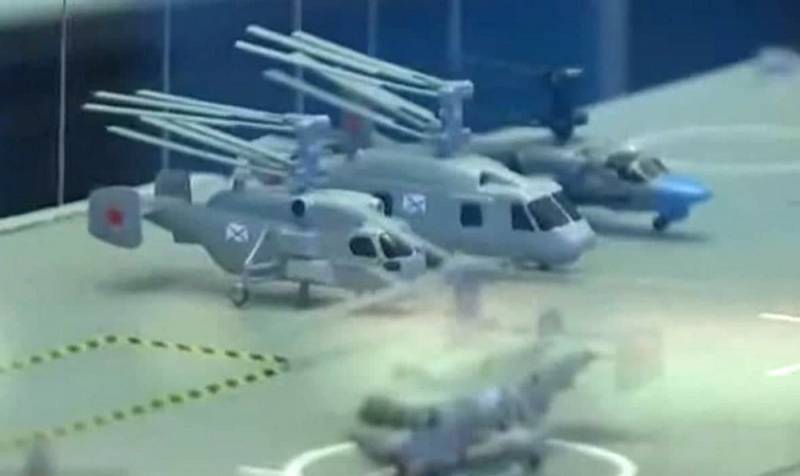+18
jaguar_br
owais.usmani
flamming_python
Cyberspec
Isos
Regular
archangelski
Rodion_Romanovic
GarryB
GunshipDemocracy
LMFS
Benya
PapaDragon
KoTeMoRe
SeigSoloyvov
hoom
mack8
George1
22 posters
Promising Naval Helicopter "Minoga" (Lamprey)

owais.usmani- Posts : 1852
Points : 1848
Join date : 2019-03-27
Age : 38
^^That looks more like a transport helicopter rather than an anti-submarine one.

Isos- Posts : 11668
Points : 11634
Join date : 2015-11-07
owais.usmani wrote:^^That looks more like a transport helicopter rather than an anti-submarine one.
Just like ka-27, it will be a family of helicopters rather than just an ASW helicopter.
GarryB likes this post

PapaDragon- Posts : 13669
Points : 13709
Join date : 2015-04-26
Location : Fort Evil, Serbia
owais.usmani wrote:^^That looks more like a transport helicopter rather than an anti-submarine one.
That's not Minoga, that's old concept for high-speed helicopter
Minoga is grey one on the right:


jaguar_br- Posts : 35
Points : 37
Join date : 2015-03-07
Why don't they just take advantage of the Mi-38, which is already available, to develop an naval version of it?

wilhelm- Posts : 348
Points : 352
Join date : 2014-12-09
jaguar_br wrote:Why don't they just take advantage of the Mi-38, which is already available, to develop an naval version of it?
Because it is overly large for the naval shipborne role for many vessels.
Its fuselage without rotors turning is 20 meters long, and has a rotor diameter of over 21 meters.

PapaDragon- Posts : 13669
Points : 13709
Join date : 2015-04-26
Location : Fort Evil, Serbia
wilhelm wrote:jaguar_br wrote:Why don't they just take advantage of the Mi-38, which is already available, to develop an naval version of it?
Because it is overly large for the naval shipborne role for many vessels.
Its fuselage without rotors turning is 20 meters long, and has a rotor diameter of over 21 meters.
Also coaxial helicopters are much more stable than standard ones
And safer to be around

GarryB- Posts : 41148
Points : 41650
Join date : 2010-03-30
Location : New Zealand
The size of the helicopter will be tied to the ship's standards, and the machine itself will receive modules for installing weapons.
That makes it sound like it will be the same size as the Helix helicopters, while the modules make it sound like an enlarged Ka-226 type design with modules that can be replaced to change role.
In contrast the image above appears to be more like a naval Mi-38 with coaxial rotors and a pusher prop...one of the land based high speed helicopter competitors...
The Mi-54 springs to mind for some reason...
Why don't they just take advantage of the Mi-38, which is already available, to develop an naval version of it?
Because it is much bigger than any model Helix and would not fit.
The added problem is that the Mi-38 has a tail rotor which is rather dangerous on a ship.
As PD mentions the coaxial rotor design handles cross winds better... a helicopter with a tail rotor generally has to turn its nose into the wind and then nod or raise its nose in the oncoming wind to maintain station... close your eyes and imagine what happens to a helicopters tail rotor when the pilot swings his nose into the prevailing wind and nods his nose up and down... who likes Sushi?

George1- Posts : 18618
Points : 19121
Join date : 2011-12-22
Location : Greece
GarryB likes this post

LMFS- Posts : 5230
Points : 5226
Join date : 2018-03-03
According to Flateric, this is a generic model that does not correspond to the latest layout. Whatever that may mean 

Isos- Posts : 11668
Points : 11634
Join date : 2015-11-07
LMFS wrote:According to Flateric, this is a generic model that does not correspond to the latest layout. Whatever that may mean
It means it just a toy for decorating the model of ship they presented. It is there to show that you can carry different classes of helicopters.
If you want to see the real model of Minoga then you go where choppers are exposed, not where ships are exposed.
Shipbuilders have nothing to do with helicopters.

GarryB- Posts : 41148
Points : 41650
Join date : 2010-03-30
Location : New Zealand
The different developers do communicate because the new Minoga, which we really don't know a lot about, but we do know it will have to operate from ships that currently operate Helix helicopters, so its dimensions need to be similar to the current Helix... and on that model we can see the Mi-38 is similar but longer body fuselage and with a tail rotor sticking out.
It is safe to assume Minoga will likely have the cross section shape of the Helix so it can continue to use lifts and hangars designed for that aircraft, but that it will likely have a longer fuselage for more internal space... coaxial rotors because the hangars are tall and the lower decks are tall to accomodate the Helix and Hokum types already.
I suspect the fundamental change will be a rear ramp door which might make a pusher propeller a non starter, but then a high speed transport helicopter that goes 500km/h supported by Hokum helicopters able to go 300km/h does not make much sense anyway.
The Minoga is likely to be a cross between a Helix and a Mi-38 with the latters increased cabin length and rear ramp door, while the rotors will be from the Helix and likely with more powerful engines.
The main difference between the Ka-25 and Ka-27 range was more cabin volume and much more powerful engines too...
There is not a lot wrong with the Helix, but a rear ramp door and more internal space would be obvious and easy improvements that would allow them to continue using the same ships with the same facilities and using the helicopters together.
Personally I would love to see a navalised Mi-38 take over the role of the Mi-14 which was a very capable anti sub and maritime patrol platform.
A ship shaped lower fuselage optimised for landing on the water would be useful but would require helicopter roof mounted electro-optics... and perhaps a mast mounted radar array based on experience with Mi-28NMs.
It is safe to assume Minoga will likely have the cross section shape of the Helix so it can continue to use lifts and hangars designed for that aircraft, but that it will likely have a longer fuselage for more internal space... coaxial rotors because the hangars are tall and the lower decks are tall to accomodate the Helix and Hokum types already.
I suspect the fundamental change will be a rear ramp door which might make a pusher propeller a non starter, but then a high speed transport helicopter that goes 500km/h supported by Hokum helicopters able to go 300km/h does not make much sense anyway.
The Minoga is likely to be a cross between a Helix and a Mi-38 with the latters increased cabin length and rear ramp door, while the rotors will be from the Helix and likely with more powerful engines.
The main difference between the Ka-25 and Ka-27 range was more cabin volume and much more powerful engines too...
There is not a lot wrong with the Helix, but a rear ramp door and more internal space would be obvious and easy improvements that would allow them to continue using the same ships with the same facilities and using the helicopters together.
Personally I would love to see a navalised Mi-38 take over the role of the Mi-14 which was a very capable anti sub and maritime patrol platform.
A ship shaped lower fuselage optimised for landing on the water would be useful but would require helicopter roof mounted electro-optics... and perhaps a mast mounted radar array based on experience with Mi-28NMs.

hoom- Posts : 2352
Points : 2340
Join date : 2016-05-06
It definitely corresponds to the chopper in the right of post 53 picture.Isos wrote:It means it just a toy for decorating the model of ship they presented. It is there to show that you can carry different classes of helicopters.
If you want to see the real model of Minoga then you go where choppers are exposed, not where ships are exposed.

GarryB- Posts : 41148
Points : 41650
Join date : 2010-03-30
Location : New Zealand
Obviously there is nothing categorical about a model.
Models of new potential Soviet aircraft carriers in the 1970s had MiG-23 model fighters on them just as an example.
Turned out that with more thrust and wing area that MiG-29s and Su-27s could be modified for the job more easily and so there were no carrier based MiG-23s.
I am just relieved there are no VSTOL fighters... that would be terrible.
Models of new potential Soviet aircraft carriers in the 1970s had MiG-23 model fighters on them just as an example.
Turned out that with more thrust and wing area that MiG-29s and Su-27s could be modified for the job more easily and so there were no carrier based MiG-23s.
I am just relieved there are no VSTOL fighters... that would be terrible.

Podlodka77- Posts : 2589
Points : 2591
Join date : 2022-01-06
Location : Z
03.10.2022
Independent military opinion
Mysterious air "MINOGA"
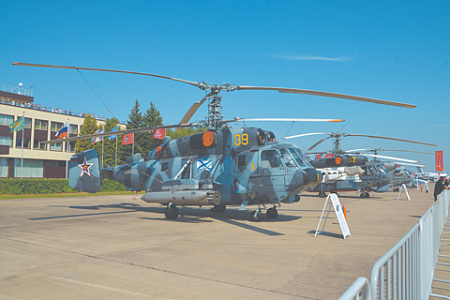
The Kamov Design Bureau is developing a promising model to replace the existing family based on the Ka-27. Photo by Vladimir Karnozov.
Work continues in Russia on the creation of promising helicopters
In mid-September of this year, 120 years have passed since the birth of the outstanding Soviet aircraft designer Nikolai Ilyich Kamov. His name is forever associated with the history of the domestic helicopter industry.
Nikolai Kamov belonged to a galaxy of designers who are rightfully called the founders of our aviation. Over 50 years of work, Nikolai Kamov has created a number of coaxial helicopters, from the small Ka-8 to heavy machines, such as the Ka-22 rotorcraft and the Ka-27 ship helicopter.
Rotary-wing aircraft with the letters "Ka" on board fly not only in Russia, but also in many countries of the world.
In honor of the anniversary of the outstanding aircraft designer, a solemn rally was held at the Mil and Kamov National Helicopter Center JSC. All speakers highly appreciated the contribution of Nikolai Ivanovich Kamov to the Soviet and Russian helicopter industry. Flowers were laid at the monument to the aircraft designer. Also, as part of the celebrations, a restored Ka-15 helicopter was demonstrated.
A scientific and technical conference dedicated to the 120th anniversary of the birth of Nikolai Kamov was held at JSC NCV Mil and Kamov. It heard about 50 reports on the problems of the domestic helicopter industry.
In the reports of several speakers, the name of the Lamprey helicopter flashed. At the same time, it was not said what this machine is, its characteristics were not announced.
Let's try to fill this gap.
BY ORDER OF THE NAVY
Information about the development of "Minoga" first appeared in August 2015. On the sidelines of the International Aviation and Space Salon in Zhukovsky, the head of the naval aviation of the Russian Navy, Major General Igor Kozhin, said that Kamov JSC should present a new helicopter by 2020.
The machine will be designed to detect, track and destroy enemy submarines. The new carrier-based helicopter should replace the Ka-27 helicopters in the Navy, which have been in service with the fleet since the 1980s.
Kamovites had to solve a difficult task. A number of special requirements were presented to the marine helicopter. For example, a car must land and take off in pitching conditions. The aerodynamics of a deck helicopter and its control system are noticeably different from the army model.
Also, a marine helicopter must withstand the effects of salt fog. The materials from which it is made are subject to stringent anti-corrosion requirements.
In addition, for the purpose of anti-submarine warfare for the new helicopter, it is necessary to develop a descending hydroacoustic station (GAS), a magnetometer, equipment for working with radio-acoustic buoys (RGAB) and data transmission for interaction with anti-submarine warfare forces (PLB). As well as depth charges, anti-submarine torpedoes, anti-ship missiles and much more.
The helicopter is created according to the Kamov scheme, that is, with two coaxial propellers. It is assumed that the Lamprey helicopters will go to the fleet in anti-submarine, transport and landing versions.
In August 2016, General Designer of Kamov JSC Sergey Mikheev said that it would take about 10 years for the development work on the Lamprey (Ka-65). According to him, the command of the Russian Navy "confirmed the need to develop a new generation of helicopters."
According to the developer, "Minoga" will be a universal machine, "quickly transformable into various applications." The weight and size characteristics of the Ka-65 will not differ significantly from the Soviet predecessor.
“Sooner or later, the replacement of the Ka-27 is necessary, and the Minoga helicopter will become this replacement. Its task is to combine the functions that were implemented on the Ka-27, ”says the materials of Russian Helicopters.
ALL-WEATHER MULTI-PURPOSE HELICOPTER
Ka-65 will be a completely new machine.
The armament of the "Minoga" will be unified with modern models. The time of maritime helicopters with a narrow specialization has passed. According to domestic experts, the emergence of a multifunctional deck machine will reduce the cost of a serial model and the cost of operating helicopters in the army.
Also, the possibility of creating an unmanned version of the Ka-65 by order of the Ministry of Defense of the Russian Federation is not ruled out.
This approach, which involves a bet on universality, is fully consistent with modern realities. This is the implementation of the so-called modular principle, which allows, depending on the task, to install appropriate on-board equipment and weapons on the vehicle.
According to the United Instrument-Making Corporation, the "Minoga" electronic equipment will be compatible with automated command and control systems for troops and combat.
Back in 2016, specialists from the Polet Research and Production Enterprise (Nizhny Novgorod) created an anti-jamming communication system for the Ka-65. It uses broadband channels, provides transmission of video recordings and data received from radar stations. As expected, the product will increase the level of efficiency of information transfer at all stages of flight.
It is also known that the Lamprey will receive a TV7-117VK turboshaft power plant developed by Klimov JSC (St. Petersburg). The upgraded versions of the Mi-28 and Ka-52 reconnaissance and attack helicopters are equipped with this engine. The takeoff power of the TV7-117VK power plant reaches 3000 hp. (for the Ka-27 power plant - 2225 hp). In emergency (afterburner) mode, the engines develop a power of 3750 hp.
Obviously, the Minoga engine will be more powerful and most likely more economical than the Ka-27. An indicator of 3000 hp suggests that the new helicopter will have improved speed characteristics.
It is planned to install a new generation communication complex on the new helicopter, which provides voice communication, transmission of video information, radar data and navigation. The new communication complex implements packet data exchange in digital form, broadband radio communication channels, new methods of dealing with interference, which increases the speed of information transfer, range and quality of communication.
The number of external antennas is kept to a minimum. In particular, the Aist-62 antenna system will be built into the skin of the helicopter's airframe.
NOT ALL THAT GLITTERS GOLD
Despite the outstanding characteristics of the "Minoga", many domestic experts argue that this project has a dead end concept. The new helicopter should replace the Ka-27/M/PS and Ka-29. But the Navy is building ships according to projects that include overall characteristics for the Ka-27 helicopter.
The concept of the Ka-27 helicopter has already exhausted itself, because it came out of the predecessor helicopter Ka-25 (for comparison, the Ka-25 weighed 6 tons, and the Ka-27 weighed 10 tons). At the same time, the Lamprey model is larger in size than the Ka-27, because the length and diameter of the screw are taken from the Ka-52, so that production can be unified.
It turns out that most single-based ships will not be able to receive the Lamprey. And if you focus on the dimensions of the Ka-27, you will not be able to get improved performance. In addition, even more powerful engines will not improve the performance of the helicopter, because the engines and gearbox make up a third of its weight.
It is also unclear why it is necessary to install such a powerful engine on the "Minoga". After all, the Mi-38 uses a TV7-117V engine with a capacity of 2800 hp, but this helicopter has a maximum take-off weight of 4 tons (that is, almost a third) more. It can carry 30 troops - against 16 on the Ka-29. It would be more correct to choose not the most powerful engine for 2500 - 2800 hp, but the most economical one.
In the distant future, "Minoga" will be able to enter the aviation group of universal landing ships (UDC) pr. 23900. Each such UDC will be able to carry up to 16 helicopters of various types, including transport-combat, landing and attack.
In the future, a decision may be made to build an aircraft carrier - and such a ship will also not do without multi-purpose helicopters.
WAIT IS NOT LONG
On November 28, 2014, the Ministry of Defense of the Russian Federation signed a contract with the Kamov Design Bureau for the creation of a promising marine helicopter for the Russian Navy. In 2016, it was announced that the Ka-65 would enter the troops in 10 years, that is, by 2026.
At the beginning of 2020, the management of the Russian Helicopters holding approved the terms of the technical assignment with the military. And in the summer of the same year, within the framework of the Army-2020 International Military-Technical Forum, they signed an agreement to develop a technical project for a future helicopter.
In September of the same year, Andrey Boginsky, General Director of the Russian Helicopters holding, announced that the first prototype of the newest Minoga helicopter, developed on the instructions of the Russian Navy, would take to the air in 2025.
It was then that the separation from the ground and the “hovering” of the prototype “Lamprey” would occur. Well, we will look forward to this event, if nothing happens during this time!
Valery Ageev
Valery Vladimirovich Ageev is a historian of aviation and cosmonautics, a journalist.
https://vpk.name/news/636441_zagadochnaya_vozdushnaya_minoga.html
Independent military opinion
Mysterious air "MINOGA"

The Kamov Design Bureau is developing a promising model to replace the existing family based on the Ka-27. Photo by Vladimir Karnozov.
Work continues in Russia on the creation of promising helicopters
In mid-September of this year, 120 years have passed since the birth of the outstanding Soviet aircraft designer Nikolai Ilyich Kamov. His name is forever associated with the history of the domestic helicopter industry.
Nikolai Kamov belonged to a galaxy of designers who are rightfully called the founders of our aviation. Over 50 years of work, Nikolai Kamov has created a number of coaxial helicopters, from the small Ka-8 to heavy machines, such as the Ka-22 rotorcraft and the Ka-27 ship helicopter.
Rotary-wing aircraft with the letters "Ka" on board fly not only in Russia, but also in many countries of the world.
In honor of the anniversary of the outstanding aircraft designer, a solemn rally was held at the Mil and Kamov National Helicopter Center JSC. All speakers highly appreciated the contribution of Nikolai Ivanovich Kamov to the Soviet and Russian helicopter industry. Flowers were laid at the monument to the aircraft designer. Also, as part of the celebrations, a restored Ka-15 helicopter was demonstrated.
A scientific and technical conference dedicated to the 120th anniversary of the birth of Nikolai Kamov was held at JSC NCV Mil and Kamov. It heard about 50 reports on the problems of the domestic helicopter industry.
In the reports of several speakers, the name of the Lamprey helicopter flashed. At the same time, it was not said what this machine is, its characteristics were not announced.
Let's try to fill this gap.
BY ORDER OF THE NAVY
Information about the development of "Minoga" first appeared in August 2015. On the sidelines of the International Aviation and Space Salon in Zhukovsky, the head of the naval aviation of the Russian Navy, Major General Igor Kozhin, said that Kamov JSC should present a new helicopter by 2020.
The machine will be designed to detect, track and destroy enemy submarines. The new carrier-based helicopter should replace the Ka-27 helicopters in the Navy, which have been in service with the fleet since the 1980s.
Kamovites had to solve a difficult task. A number of special requirements were presented to the marine helicopter. For example, a car must land and take off in pitching conditions. The aerodynamics of a deck helicopter and its control system are noticeably different from the army model.
Also, a marine helicopter must withstand the effects of salt fog. The materials from which it is made are subject to stringent anti-corrosion requirements.
In addition, for the purpose of anti-submarine warfare for the new helicopter, it is necessary to develop a descending hydroacoustic station (GAS), a magnetometer, equipment for working with radio-acoustic buoys (RGAB) and data transmission for interaction with anti-submarine warfare forces (PLB). As well as depth charges, anti-submarine torpedoes, anti-ship missiles and much more.
The helicopter is created according to the Kamov scheme, that is, with two coaxial propellers. It is assumed that the Lamprey helicopters will go to the fleet in anti-submarine, transport and landing versions.
In August 2016, General Designer of Kamov JSC Sergey Mikheev said that it would take about 10 years for the development work on the Lamprey (Ka-65). According to him, the command of the Russian Navy "confirmed the need to develop a new generation of helicopters."
According to the developer, "Minoga" will be a universal machine, "quickly transformable into various applications." The weight and size characteristics of the Ka-65 will not differ significantly from the Soviet predecessor.
“Sooner or later, the replacement of the Ka-27 is necessary, and the Minoga helicopter will become this replacement. Its task is to combine the functions that were implemented on the Ka-27, ”says the materials of Russian Helicopters.
ALL-WEATHER MULTI-PURPOSE HELICOPTER
Ka-65 will be a completely new machine.
The armament of the "Minoga" will be unified with modern models. The time of maritime helicopters with a narrow specialization has passed. According to domestic experts, the emergence of a multifunctional deck machine will reduce the cost of a serial model and the cost of operating helicopters in the army.
Also, the possibility of creating an unmanned version of the Ka-65 by order of the Ministry of Defense of the Russian Federation is not ruled out.
This approach, which involves a bet on universality, is fully consistent with modern realities. This is the implementation of the so-called modular principle, which allows, depending on the task, to install appropriate on-board equipment and weapons on the vehicle.
According to the United Instrument-Making Corporation, the "Minoga" electronic equipment will be compatible with automated command and control systems for troops and combat.
Back in 2016, specialists from the Polet Research and Production Enterprise (Nizhny Novgorod) created an anti-jamming communication system for the Ka-65. It uses broadband channels, provides transmission of video recordings and data received from radar stations. As expected, the product will increase the level of efficiency of information transfer at all stages of flight.
It is also known that the Lamprey will receive a TV7-117VK turboshaft power plant developed by Klimov JSC (St. Petersburg). The upgraded versions of the Mi-28 and Ka-52 reconnaissance and attack helicopters are equipped with this engine. The takeoff power of the TV7-117VK power plant reaches 3000 hp. (for the Ka-27 power plant - 2225 hp). In emergency (afterburner) mode, the engines develop a power of 3750 hp.
Obviously, the Minoga engine will be more powerful and most likely more economical than the Ka-27. An indicator of 3000 hp suggests that the new helicopter will have improved speed characteristics.
It is planned to install a new generation communication complex on the new helicopter, which provides voice communication, transmission of video information, radar data and navigation. The new communication complex implements packet data exchange in digital form, broadband radio communication channels, new methods of dealing with interference, which increases the speed of information transfer, range and quality of communication.
The number of external antennas is kept to a minimum. In particular, the Aist-62 antenna system will be built into the skin of the helicopter's airframe.
NOT ALL THAT GLITTERS GOLD
Despite the outstanding characteristics of the "Minoga", many domestic experts argue that this project has a dead end concept. The new helicopter should replace the Ka-27/M/PS and Ka-29. But the Navy is building ships according to projects that include overall characteristics for the Ka-27 helicopter.
The concept of the Ka-27 helicopter has already exhausted itself, because it came out of the predecessor helicopter Ka-25 (for comparison, the Ka-25 weighed 6 tons, and the Ka-27 weighed 10 tons). At the same time, the Lamprey model is larger in size than the Ka-27, because the length and diameter of the screw are taken from the Ka-52, so that production can be unified.
It turns out that most single-based ships will not be able to receive the Lamprey. And if you focus on the dimensions of the Ka-27, you will not be able to get improved performance. In addition, even more powerful engines will not improve the performance of the helicopter, because the engines and gearbox make up a third of its weight.
It is also unclear why it is necessary to install such a powerful engine on the "Minoga". After all, the Mi-38 uses a TV7-117V engine with a capacity of 2800 hp, but this helicopter has a maximum take-off weight of 4 tons (that is, almost a third) more. It can carry 30 troops - against 16 on the Ka-29. It would be more correct to choose not the most powerful engine for 2500 - 2800 hp, but the most economical one.
In the distant future, "Minoga" will be able to enter the aviation group of universal landing ships (UDC) pr. 23900. Each such UDC will be able to carry up to 16 helicopters of various types, including transport-combat, landing and attack.
In the future, a decision may be made to build an aircraft carrier - and such a ship will also not do without multi-purpose helicopters.
WAIT IS NOT LONG
On November 28, 2014, the Ministry of Defense of the Russian Federation signed a contract with the Kamov Design Bureau for the creation of a promising marine helicopter for the Russian Navy. In 2016, it was announced that the Ka-65 would enter the troops in 10 years, that is, by 2026.
At the beginning of 2020, the management of the Russian Helicopters holding approved the terms of the technical assignment with the military. And in the summer of the same year, within the framework of the Army-2020 International Military-Technical Forum, they signed an agreement to develop a technical project for a future helicopter.
In September of the same year, Andrey Boginsky, General Director of the Russian Helicopters holding, announced that the first prototype of the newest Minoga helicopter, developed on the instructions of the Russian Navy, would take to the air in 2025.
It was then that the separation from the ground and the “hovering” of the prototype “Lamprey” would occur. Well, we will look forward to this event, if nothing happens during this time!
Valery Ageev
Valery Vladimirovich Ageev is a historian of aviation and cosmonautics, a journalist.
https://vpk.name/news/636441_zagadochnaya_vozdushnaya_minoga.html
GarryB, LMFS, Hole and Broski like this post

GarryB- Posts : 41148
Points : 41650
Join date : 2010-03-30
Location : New Zealand
The Ka-27 was actually in service for a while before the west actually noticed it was a new aircraft.
Honestly new higher speed higher lift rotors, new engines and ramp rear door as well as side doors and it will be an improvement.
Actually I read somewhere that the gearbox and transmission for the coaxial rotor on the Hokum and Helix types weighs 3.5 tons... the actual engines are rather light... about 300kgs each dry weight...
Perhaps new technology electric drive could eliminate the bulky complex gearbox and transmission and they can have something with better than existing performance that is perhaps 3 tons lighter...
Honestly new higher speed higher lift rotors, new engines and ramp rear door as well as side doors and it will be an improvement.
Actually I read somewhere that the gearbox and transmission for the coaxial rotor on the Hokum and Helix types weighs 3.5 tons... the actual engines are rather light... about 300kgs each dry weight...
Perhaps new technology electric drive could eliminate the bulky complex gearbox and transmission and they can have something with better than existing performance that is perhaps 3 tons lighter...
Podlodka77 likes this post
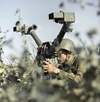
Mir- Posts : 4121
Points : 4119
Join date : 2021-06-10
Podlodka77 wrote:
Despite the outstanding characteristics of the "Minoga", many domestic experts argue that this project has a dead end concept. The new helicopter should replace the Ka-27/M/PS and Ka-29. But the Navy is building ships according to projects that include overall characteristics for the Ka-27 helicopter.
The concept of the Ka-27 helicopter has already exhausted itself, because it came out of the predecessor helicopter Ka-25 (for comparison, the Ka-25 weighed 6 tons, and the Ka-27 weighed 10 tons). At the same time, the Lamprey model is larger in size than the Ka-27, because the length and diameter of the screw are taken from the Ka-52, so that production can be unified.
It turns out that most single-based ships will not be able to receive the Lamprey. And if you focus on the dimensions of the Ka-27, you will not be able to get improved performance. In addition, even more powerful engines will not improve the performance of the helicopter, because the engines and gearbox make up a third of its weight.
It is also unclear why it is necessary to install such a powerful engine on the "Minoga". After all, the Mi-38 uses a TV7-117V engine with a capacity of 2800 hp, but this helicopter has a maximum take-off weight of 4 tons (that is, almost a third) more. It can carry 30 troops - against 16 on the Ka-29. It would be more correct to choose not the most powerful engine for 2500 - 2800 hp, but the most economical one.
The Minoga would have been designed from day one to fit inside the hanger space on Russian Navy Destroyers/Frigates - the same way that the Ka-27 was designed to replace the "smaller" Ka-25.
If you look at the model presented as the Minoga you will notice it is significantly longer than the Ka-27 but if you look even more carefully (second picture)you will see that they presented a second model on the Ivan Rogov in the "rest" position. This model displays a retractable rear end that will make it no larger than the Ka-27. The wider fuselage of the Minoga is also not a problem as the Ka-27 sits quite wide on its own landing gear.
The Minoga is on the left with the Ka-27 to the right>>
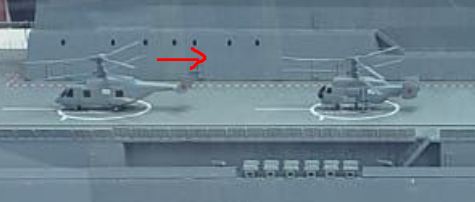
Notice the Minoga's size compared to Ka-27 behind it>>

GarryB, Sprut-B, Broski and Podlodka77 like this post

GarryB- Posts : 41148
Points : 41650
Join date : 2010-03-30
Location : New Zealand
If you look at a Helix from the front you will notice how wide the main gear wheels are... this is good for stability on a ship obviously for landing and taking off, but I always thought when being moved and put in storage either in a hangar or whereever that the wheels could have been retracted inwards to take up less space.
Just looking at this image shows you could double the width of the fuselage and still be no wider than the current Ka-32/27 family...
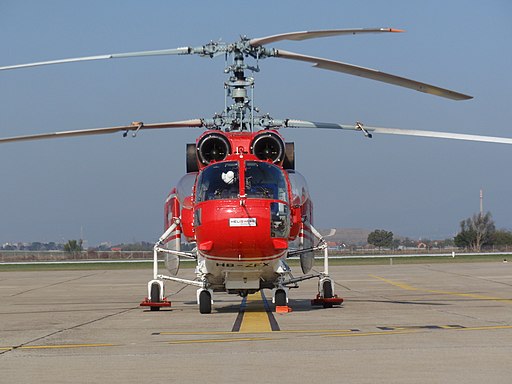
And of course lengthwise you can extend the body forward and back a bit because the tail can stay the same length but extending the front a little further forward but also extending the rear of the fuselage to add a ramp rear door can actually be done without making the tail longer (it will make it heavier so the front extended forward a bit would balance that out more).
They essentially did the same thing with the upgrade from the Ka-25 to the Ka-27...
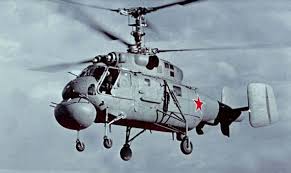
Ka-25
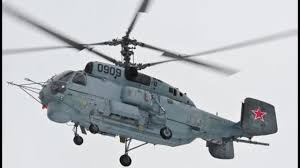
Ka-32.
The rotor diameter of the Ka-50 is 14.5m... AFAIK they did not change that for the later Ka-52s... and the rotor diameter of the Ka-32 is 15.9m... so the Lamprey having the Ka-52s main rotor means it could be smaller than the Ka-32.
Remember the Lamprey has to fit where the Ka-27 and Ka-29 and Ka-31 and Ka-32 aircraft used to operate...
Just looking at this image shows you could double the width of the fuselage and still be no wider than the current Ka-32/27 family...

And of course lengthwise you can extend the body forward and back a bit because the tail can stay the same length but extending the front a little further forward but also extending the rear of the fuselage to add a ramp rear door can actually be done without making the tail longer (it will make it heavier so the front extended forward a bit would balance that out more).
They essentially did the same thing with the upgrade from the Ka-25 to the Ka-27...

Ka-25

Ka-32.
At the same time, the Lamprey model is larger in size than the Ka-27, because the length and diameter of the screw are taken from the Ka-52, so that production can be unified.
The rotor diameter of the Ka-50 is 14.5m... AFAIK they did not change that for the later Ka-52s... and the rotor diameter of the Ka-32 is 15.9m... so the Lamprey having the Ka-52s main rotor means it could be smaller than the Ka-32.
Remember the Lamprey has to fit where the Ka-27 and Ka-29 and Ka-31 and Ka-32 aircraft used to operate...

GunshipDemocracy- Posts : 6171
Points : 6191
Join date : 2015-05-17
Location : fishin on Stalin´s Strait between Mexico and Canada
The original material was published on Nezavisimaya Gazeta (independent Newspaper) i.e. 5th column outlet
in subcolumn:
https://nvo.ng.ru/
nvo - nezavisimye voyenoye obozrennye - independent military review .
where In Russia "independent" usually means 5th column or directly funded form abroad.
author:
Valery Ageev
Valery Vladimirovich Ageev is a historian of aviation and astronautics, a journalist.
Kids so you treat seriously 5th column journo wannabe expert? this scum is going to claim that everything made in Russia is crap .
in subcolumn:
https://nvo.ng.ru/
nvo - nezavisimye voyenoye obozrennye - independent military review .
where In Russia "independent" usually means 5th column or directly funded form abroad.
author:
Valery Ageev
Valery Vladimirovich Ageev is a historian of aviation and astronautics, a journalist.
Kids so you treat seriously 5th column journo wannabe expert? this scum is going to claim that everything made in Russia is crap .
Big_Gazza and Hole like this post

mnztr- Posts : 2994
Points : 3034
Join date : 2018-01-21
I wonder how the gearbox weight compares to a single rotor+tail rotor setup. i cannot see it being dramatically heavier. Its not that much complexity to get a second shaft turning in the opposite direction.



 Isos
Isos